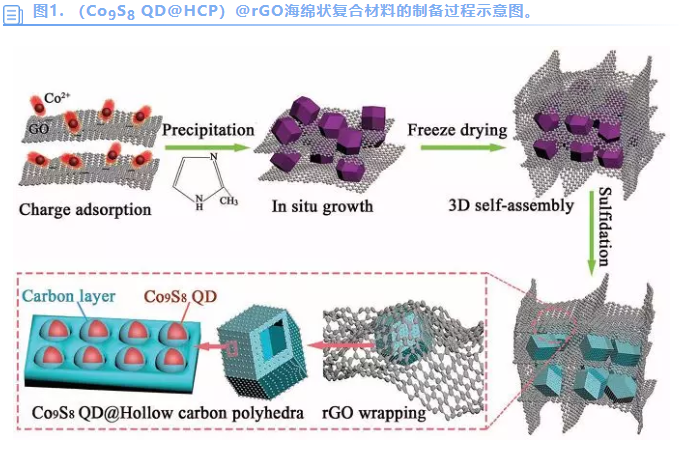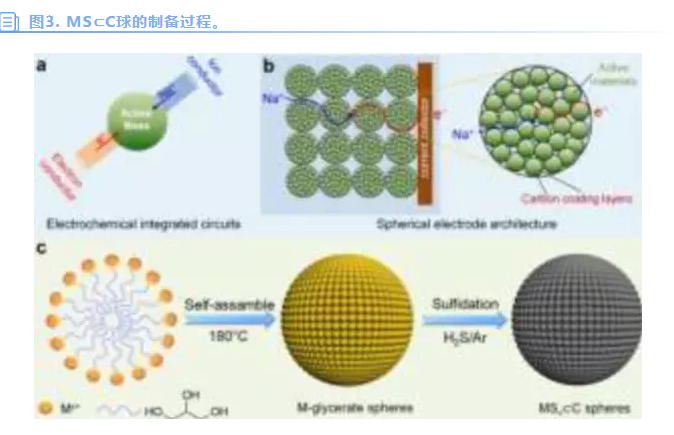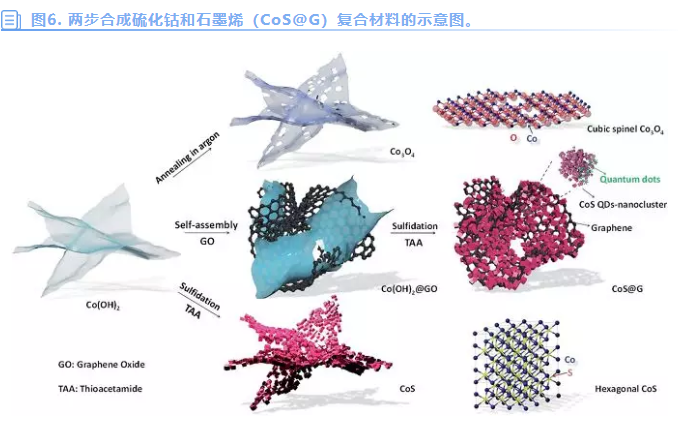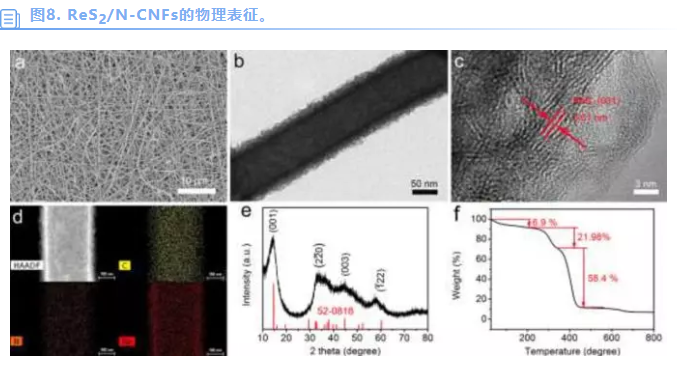
hotline:
17715390137
Tel/Wechat:
18101240246 (Technology)
0512-68565571
Email:mxenes@163.com (Sales Engineer)bkxc.bonnie@gmail.com
Scan the code to follow or search the official account on WeChat:
2D Materials Fronrier After paying attention,
click on the lower right corner to contact us,
Enter enterprise WeChat.
Professional Services Online

已传文件:photo/2020721103915882.png

The research group of Professor Dalin Sun of Fudan University prepared the cobalt sulfide quantum dots (Co9S8 QD), mesoporous hollow carbon polyhedron (HCP) matrix and graphene oxide through the @GO precursor synthesized by the thermal reduction, carbonization and sulfidation of the zeolite imidazole salt framework. (RGO) Sponge-like composite material assembled by wrapping sheets, as shown in Figure 1. [1, 2] Specifically, Co9S8 QD with a size of less than 4 nm was uniformly embedded in the HCP matrix, which was encapsulated in the macroporous rGO, thereby producing a double-carbon constrained layered composite material with strong coupling effect. The combination of experimental data and density functional theory calculations shows that the presence of coupled rGO can not only prevent particle aggregation and overgrowth, but also extend the lattice parameters of the matrix crystal, thereby enhancing the reactivity of sodium storage. Thanks to the layered porosity, conductive network, structural integrity, and synergistic effects of components, the sponge-like composite material used as a binder-free anode exhibits excellent sodium storage performance and excellent stable capacity (500 cycles) The rear capacity ranges from 628 mAh g-1 to 300 mA g-1) and excellent rate performance (529, 448, and 330 mAh g-1 at current densities of 1600, 3200, and 6400 mA g-1, respectively).

Professor Changzhou Yuan from Jinan University and Professor Lou Xiongwen from Nanyang Ligong University collaborated to synthesize a hybrid membrane composed of Fe1-xS filled porous carbon nanowires/graphene oxide (Fe1-xS@PCNWs/rGO) through a simple assembly and vulcanization strategy ,as shown in picture 2. [3] The resulting mixed film exhibits high flexibility and structural stability. The multi-dimensional membrane structure has multiple advantages, including providing an effective electron/ion transport network, buffering the volume expansion of Fe1-xS nanoparticles, reducing the dissolution of polysulfides, and achieving excellent kinetics for efficient sodium storage. When evaluated as a self-supporting anode for sodium-ion batteries, the Fe1-xS@PCNWs/rGO electrode showed excellent reversible capacity (573-89 mAh g-1) after 100 continuous cycles of 0.1 A g-1. More competitively, the sodium ion battery based on this flexible Fe1-xS@PCNWs/rGO anode has excellent electrochemical performance, which highlights its huge potential in a variety of flexible and wearable applications.

The research group of Professor Yan Yu from the Max Planck Institute for Solid State Research in Germany showed that the problems caused by the conversion reaction of sodium-ion batteries can be overcome through a reasonable electrode design that establishes an effective electronic/ion hybrid conductive network. The preparation of graded carbon-coated metal sulfide (MS⊂C) balls by thermal vulcanization of metal glycerides has been developed, as shown in Figure 3. [4] The ball shows a highly reversible sodium storage capacity of 777 mAh g-1 at a current density of 100 mA g-1, and excellent rate performance (a capacity of 410 mAh g-1 at a current density of 4000 mA g-1) ) And very excellent cycle stability.

【Aluminum ion battery】
The research group of Professor Shandong Li from Qingdao University reported on a new multilayer system structure of FeS2@C hybrids designed using a solvothermal method combined with a vulcanization strategy. Electrochemical energy storage, as shown in Figure 4. [5] Electrochemical measurements show that the multilayer structure of FeS2@C hybrid can realize a reversible sodium, potassium and aluminum ion storage process with high specific capacity, excellent rate performance and excellent cycle stability.

The research team of Academician Cheng Huiming of the Institute of Metals of the Chinese Academy of Sciences reported a highly reversible aluminum ion battery using porous Co3S4 microspheres as the cathode material, as shown in Figure 5. [6] The microstructure makes the electrochemical performance of Co3S4 superior to most other cathode materials reported so far for aluminum ion batteries. Further results show that the battery has undergone Al3+ insertion/extraction with Co3+/Co2+ as a redox pair in the cathode, and electrochemical stripping/plating of metal aluminum in the anode. The author also found that the diffusion of Al3+ in the Co3S4 bulk is a key kinetic step that limits the discharge/charge current density. This work is a step in the development of low-cost cathode materials for high-performance aluminum-ion batteries and will help to better understand the chemistry of aluminum-ion batteries.

【Potassium ion battery】
Professor Guo Zaiping’s group from the University of Wollongong in Australia reported for the first time a composite of cobalt sulfide and graphene (CoS@G) as the anode electrode of a potassium ion battery, as shown in Figure 6. [7] The composite material has interconnected quantum dots of CoS nanoclusters uniformly anchored on graphene nanosheets. The coexistence of CoS quantum dot nanoclusters and graphene nanosheets gives the composite material a larger surface area, a highly conductive network, strong structural stability and excellent electrochemical energy storage performance. After 100 cycles at 500 mA g-1, it still has a capacity of 310.8 mAh g-1, and its rate performance is better than that of equivalent sodium-ion batteries. This work shows that the development of CoS@G anode materials provides a basis for expanding the library of suitable anode materials for potassium ion batteries.

The research group of Professor Yanguang Li of Soochow University has developed a simple solvothermal method to prepare VS2 nanosheets, as shown in Figure 7. [8] A single nanosheet is characterized by a thickness of several atomic layers, and they are arranged in layers in a minimized stack. Electrochemical measurements show that VS2 nanosheets can quickly and stably store Na+ or K+ ions. The most striking thing is that both Na+ and K+ have larger reversible specific capacity and excellent cycle stability, and are superior to most existing electrode materials. Density functional theory calculations further support the experimental results of this study, indicating that the layered structure of VS2 has a larger adsorption energy and a lower diffusion barrier for the insertion of alkali metal ions.

The research group of Professor Chunsheng Wang from the University of Maryland fixed ReS2 nanosheets to nitrogen-doped carbon nanofibers (N-CNF) to form flexible ReS2/N-CNFs paper for the anode of alkaline metal (Li, Na and K) ion batteries , As shown in Figure 8. [9] Carbon nanofibers (CNFs) can improve electrical conductivity, and doped nitrogen can absorb sulfur and polysulfides produced by the conversion reaction. The results show that the ReS2/N-CNFs composite anode still has a reversible capacity of 430 mAh/g after 400 cycles in 100 mA/g LIB, and 245 mAh/g after 800 cycles in 100 mA/g sodium ion battery. Reversible capacity of g, and 253 mAh/g in potassium ion after 100 cycles at 50 mA/g. This performance is one of the best performances among all ReS2 recently reported. In addition, the formation of solid electrolyte interface and Coulomb efficiency on ReS2 in different alkaline ion batteries have also been systematically studied.

【references】
[1] Jingwei Chen, Daniel H. C. Chua, Pooi See Lee, The Advances of Metal Sulfides and In Situ Characterization Methods beyond Li Ion Batteries: Sodium, Potassium, and Aluminum Ion Batteries, Small Methods 2019, 1900648.
[2] Ziliang Chen, Renbing Wu, Miao Liu, Hao Wang, Hongbin Xu, Yanhui Guo, Yun Song, Fang Fang, Xuebin Yu, Dalin Sun, General Synthesis of Dual Carbon-Confined Metal Sulfides Quantum Dots Toward High-Performance Anodes for Sodium-Ion Batteries, Adv. Funct. Mater. 2017, 27, 1702046.
This information is from the Internet for academic exchanges. If there is any infringement, please contact us and delete it immediately

| Reminder: Beijing Beike New Material Technology Co., Ltd. supplies products only for scientific research, not for humans |
| All rights reserved © 2019 beijing beike new material Technology Co., Ltd 京ICP备16054715-2号 |